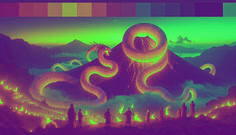Introduction
On the western rim of an island shaped like a sleeping whale, where breadfruit trees cast slow shadows over sandy paths and the reef lay like a living fence against the open ocean, there was a village that kept its stories like lanterns. The villagers spoke softly of the sea as if it could hear and answer—an old and listening thing that kept secrets and returned them in tide-silvered gifts. In the years before the great forgetting, when storms were fewer and the nets were full, a woman named Malu lived with her daughter Alofa in a fale near the shore. Malu’s hands were callused from husking taro and weaving mats, and Alofa learned to count the curving arcs of the waves the way other children learned letters. Their life moved in small, confident cycles: planting, fishing, telling, singing. But the ocean and the garden are never promises; they are partnerships whose contracts can be broken by drought and by the hungry teeth of weather. When the rains delayed and the fish went quiet beyond the outer reef, the village found itself shrinking. Taro beds cracked into dry mouths, breadfruit trees bore late and sparse fruit, and the nets came home lighter each dawn. Hunger is a teacher that strips away polite talk until what remains is raw truth: who will open their hands and who will close them. Malu and Alofa watched neighbors grow thin, watched elders recite blessings into empty bowls, and watched children fall asleep with the sounds of the sea like a distant drum behind their ribs. The chief called a meeting beneath the breadfruit; names were traded in whispers, debts and favors were laid bare. In that time of small cruelties—when people begin to measure kindness by what it costs them—Malu felt an ache that was both physical and a pressure beneath her ribs: she was mother and therefore the keeper of a promise no storm could take. The promise was simple and human: to keep her daughter safe. It was also an old promise of the island itself, the kind made by ancestors who bound themselves to the sea and the land in ways that could not be broken by hunger alone. When evening came and the village drifted toward sleep with heads full of prayers, Malu and Alofa walked to the reef and listened. They spoke in the low voice of those who know time is patient; they braided small offerings into palm-leaf cups—salted water, a scrap of cooked taro, a bead of coral—and let the tide take them. The sea received these with the indifferent courtesy of something greater. In the hush between two waves, when the moon lay like a thin coin on the water, the sea answered in a way that would change everything. A voice rose—not a voice of words but of movement: a turtle’s slow, long-breathing patience as it surfaced to feel the air, a shark’s quiet arc cutting the blue where the reef bent into deeper water. The island’s older tales spoke of such things—of relatives in other forms, of spirits who traded breath for breadfruit—but this was the sort of answer that asks for more than offerings. It asked for a choice. In the hush Malu saw, as if behind a veil, a shape of possibility: to become something that could live between the land and the open sea, to hold the place where the reef met the shore and to guard the village with two kinds of courage. The choice would mean leaving flesh and the small comforts of skin, but it would also mean keeping the promise to a child forever, in a way that hunger could not take. Alofa, warm and trusting at her mother’s side, felt the same tide of thought move through her like the pleasure of a remembered lullaby. To be near the shore was to be near their memories; to swim was to keep singing the village into being. So they made the agreement the old way—without ceremonial book or public witness, with hands clasped and a simple exchange of breath. They offered everything so that others might continue. The island’s sky watched, and the sea, older than names, listened. In that listening something shifted: skin became carapace and bone became blade; the mother’s back broadened into a domed, green-brown shell, and the daughter’s arms and shoulders sharpened into the sleek, silver line of a shark’s flank. They sank into the water as night was learning names for the coming dawn. The villagers woke to find the reef brighter, the tide cradling more fish than had been seen for moons, and two shapes—one slow and round, the other slicing silver—gliding endlessly where the reef kept the shoreline steady. The story that follows is the memory the sea kept of those who chose to stay close, an ordinary and sacred account of how family sometimes becomes a force of nature in order to protect what it loves.
Of Breadfruit, Drought, and the Decision by the Reef
The sea of memories the island carried was not tidy. It arrived as foam and as ache, as taste of salt and loss, and as the way morning light opened across a roof made of pandanus. In the first long section of the tale, the village is a living knot of small stories: elders who keep song-names, children who race crabs along the sand, women who pound coconut and trade laughter for lime-green fish. Malu's life was threaded through these ordinary centers of meaning. She rose when the sky was the color of uncut shells, fetched water, spoke in the gentle commands of a practiced hand. Her daughter, Alofa—whose name means love—learned the sea's moods by watching it: the way it could be a wide blue patience that let the canoe drift, or a coiled thing that reared up on storm nights. Those who live with the ocean learn to read it with the eyes of fishermen and mothers both; they judge a cloud by its patience, a current by the lean of the grass. The first rains failed gradually, as if the sky had decided to remember a different season. At first it was small: the taro leaves browned at the edges, then folded inward; the wells tasted faintly of iron. Nets came in with fewer fish, and people began to adjust like a body growing thinner. A family might skip a meal, then two, then keep the children from the market because it seemed an indulgence. And yet there is a particular shape to hunger that is more than an empty stomach: it is the shrinking of the public life of a village. Where there had been feasts, there were now conversations about what to preserve; where there had been offerings to the gods and the ancestors, there were new mathematics of sharing. Malu watched all of this as one watches weather—close enough to feel the pressure but not so close as to think you can stop it. Her own home kept its small light: a bowl with a little cooked taro, a scrap of dried fish that she had saved because children cannot thrive on words alone. Alofa grew thinner, but her laughter did not fully leave. It turned inward, making a quiet sound like a shell rubbed between fingers. The chief gathered the village in the fale under the breadfruit and spoke of trade with other islands, of sending out a canoe with men to barter for seeds and salted fish. But weeks stretched and the ocean gave little in return; the traders came back with promises and worry in equal measure. There were also the stories older than trade: the elders spoke of the sea as kin, of ancestors who had lain down in other shapes to guard a place. These stories were not used lightly; they were the vocabulary of those who had to decide between what they could give and what they must keep. The idea of changing shape, of becoming animal to protect a place, had the gravity of an old law. That it might be used by someone ordinary—by a woman and her daughter—made it both poignant and frightening. The night Malu and Alofa walked to the reef there was a kind of stillness as if the island itself were waiting. The moon was thin; the stars had not yet crowded the sky. They did not speak much. What they did was make small offerings: water, a scrap of breadfruit roasted to tenderness, a coil of coconut fiber. They placed them in palm-leaf cups and let the tide take them. They sat until the sea seemed like another breathing thing, slow and deep. In the space between two waves, the reef answered in ways not often given to human ears: a turtle surfaced with measured breathing, the sound soft and ancient; a blur beneath the surface moved with the precise, purposeful arc of a shark. Malu had heard the elders. She knew that such signs were invitations and that invitations demand a kind of courage that is less noisy than grief. Alofa felt the pull of the reef like a song she had always known but had never been taught to name. To stay near the shore was to remain in the village’s daily memory; to be a turtle or a shark was to accept a different kind of life, one of long patience or of swift guardianship. They made their choice not from heroics but from a place of human calculation: to protect what was left so that the rest might live. Their transformation was not the theatrical thing of different myths; it was intimate, like a slow folding of the body into something else. When Malu’s skin began to cool into the mottled green and brown of a turtle’s shell, Alofa felt no stranger than at a birth. When Alofa’s limbs lent themselves to a sleeker, muscular form that cut through water with purpose, Malu’s heart kept company with the same quiet resolution. It is important to know this: they did not leave out of despair but out of love made into action. The villagers woke in the morning to a reef that seemed to have been tended by new hands. Fish returned to edge the lagoon, and the currents brought with them small schools of silver that had skirted the deeper waters. Two shapes—one slow and rounded, the other long and clean—moved beyond the breakers and then back again, as if measuring the shoreline like a caretaker measuring a gate. People made offerings, as was the island’s way, with cocoa and prayers, and in the telling of days the two shapes took on names: the turtle who kept the shallow paths and the shark who patrolled the outer reef. Their presence became part of the village's routine and of the larger conversation about how the world looks after those who choose to guard it. Over time, the reef healed in ways both literal and tender. Children learned to leave handfuls of seaweed in tide pools, and fishermen learned to respect the places where the coral was thin and fragile. Where once nets had been trawled recklessly, there was new patience; where once curiosity had led men to chase every glint, they now watched and waited, letting the sea give what it wanted. Malu and Alofa—now in their other forms—were not merely mythic shapes but practical presences. The turtle's slow passage loosened old silt and allowed young coral to find crevices. The shark's patrol kept predators from overfeeding in the lagoon and taught the schools of fish to move in shapes that made breeding possible again. The village noticed. They began to tell their children that the sea had kept its promise because someone had kept theirs, and the story of the two forms became both a lesson and a consolation. Yet this caution must be told: such transformations carry costs. The turtle learned a different kind of remembering, one that stores time in the slow rhythm of tides rather than the hurry of days. The shark learned hunger in a new register, one of hunger not for food but for the hands that had once braided her hair. Villagers who came to the shore late in the night sometimes thought they heard singing in a language of water—muted, patient chants the two had kept between them. But the island life continued to shift; generations changed. Names were passed on, and the memory of living hands folded into ritual. The turtle and the shark remained, not as a magic solution but as an ongoing care, a quiet example of what it means to be family when the world is less kind than it was once believed to be.

Guardianship, Memory, and Waves that Speak
Time by the sea is elastic; a single tide can hold a hundred small stories. After Malu and Alofa chose to stay at the waterline—one in a carapace and one in a fin—the island acquired a new manner of speaking about loyalty and loss. The people of the village wove the presence of the turtle and the shark into their lives, not as spectacle but as steady fact. Grandmothers pointed them out to grandchildren with the half-lidded look of those who have seen mysteries and decided to make peace with them. Young lovers carved initials into pandanus, then left offerings by the shore in thanks to the two who kept the balance. Fishermen altered their nets and their habits, learning to take less from the places where the reef needed time to heal. This part of the tale is about the slow accumulation of grace: how a community, tested by hunger, learns new economies of care and how lives are shaped by those who give themselves in ways that cannot be counted. Malu the turtle became a teacher in ways that surprised even the elders. Her shell, bronze and patterned like ancient tapa cloth, broke open pools of small life as she turned, making new spaces for juvenile fish and giving seeds of coral places to lodge. Where the soil of the reef had been smothered with sand and neglect, she plowed with her weight and with a patience the island itself could recognize. Children who learned to approach the water quietly would sometimes tiptoe close and watch her, learning the slow breathing that keeps a heart steady. Alofa the shark kept a different curriculum. Her movement through the water taught the schools of fish to hold formation; her presence discouraged invasive predators that once plundered the lagoon. She was neither merciless nor cruel; she was a living boundary, a force that taught balance by being what she was. The synergy of their presence—one that tended and one that patrolled—mended not only the reef but a certain moral equilibrium in the village. The elders rewrote some of their stories, adding episodes where the two intervened in human quarrels: one time a man nearly burned the mangroves in irritation and later found, to his shame, that the tides had given back his canoe but not the same calm. The village took these as instruction. Stories are, in many island cultures, a way to teach the body how to behave. They are not merely entertainment; they are the slow grammar of belonging. So the legend of the turtle and the shark moved through daily life like a gentle current—present in songs at weddings, invoked when a child was named, consulted when a decision threatened common ground. Occasionally, though, the story wrestled with grief. People die. Children grow. The fishermen’s grandchildren did not always remember the shape of faces that had been human. Names became songs, then footnotes in new stories. There were moments when the village feared the two were tired of their duty, times when a storm would push them far and the people worried aloud. But the sea remembers differently than people; it keeps time in breaths and in coral growth, and it recognizes constancy. The turtle and the shark continued their slow, sacred rounds. They did not need to perform courage as humans do; they enacted it through presence. A narrative like this one must also speak to the smaller, quieter payments of sacrifice. For Malu, the turtle’s life stretched differently; she kept memory in the grooves of her shell and learned to love slowly. For Alofa, who had once loved dancing on shore and felt the warmth of pandanus against her feet, there was a new shape of longing. Sometimes she would near the edge of the reef at dusk, where the water draws thin and lets you see the reflection of stars, and the villagers would hear the faintest sound, like a young voice calling through a shell. No spell can remove the ache of such a trade; every gift taken on for many is also a letting go. The villagers recognized this and found rituals to keep the two close: they saved the small fish of the season and put them into the water by moonlight; mothers would sing lullabies into the tide, sending them like small boats toward the two guardians. These were not attempts to reclaim a life lost but to ensure the two remained remembered in ways that were kind. Legends change as people change their ears. In the generations after the transformation, the island met strangers—sailors and traders whose languages had the smell of tar and far ports. They came with different worldviews, with maps and names, often ignorant of the subtleties of the reef and the careful economics of island life. Some carried devices that hummed, some told tall tales of riches, and others brought the weight of new hunger in the shape of commercial nets. The villagers were forced again to choose what to protect and how. The presence of the turtle and the shark became practical counsel in these new dangers; the animals' responses to nets and to men who did not respect the reef served as a living lesson in what could be lost. In the face of outside pressures, the islanders worked to keep fa'a Samoa—the Samoan way—alive in their own terms. They held council under the breadfruit, enacted laws about which nets were permissible and where fishing was taboo, passed down the story of Malu and Alofa as both a moral and environmental text. The tale, in this sense, merged ecology and ethics into an argument for stewardship. Even when seasons returned generous and the immediate memory of famine softened into history, no one suggested altering the reef without thought. The turtle and the shark had become so integral that to change their conditions would have been to change the village itself. There are, of course, moments in the life of any myth where it must answer questions its first tellers did not imagine. Why did they not return to human form? Was there a spell unfinished? The elders answered such questions plainly: some promises are meant to bind beyond the span of a single life because some debts are to place and people who have not yet been born. The two had bound themselves not to be rescued but to rescue; that is a different kind of covenant. It is also worth saying that the ocean does not obey human time. A turtle’s life is slow and long; a shark’s memory keeps the shape of a human face sometimes and sometimes not. Yet in small things—like the way a child remembers a grandmother’s laugh—there are continuities. The island's children learned to read the tide charts like poems and to treat the reef with a tenderness that became cultural muscle. Outsiders who saw the reef’s revival sometimes called it ecological luck. The villagers preferred to call it law and gratitude. The story of the turtle and the shark did not become a monument; it became a practice. Each year, when the first heavy rains came and the breadfruit trees bent with fruit, the village celebrated. They did not erect statues or bring out brass plaques. They simply cooked and shared and brought offerings to the water. They tied small woven bracelets to the pandanus and sang songs that had begun centuries earlier. Songs are a people’s memory that cannot be privatized; they belong to whoever can carry them in the mouth and pass them on. In the chorus of those songs, Malu and Alofa were always present: the slow, sonorous voice of the turtle in the low notes, the bright, sharp counter that traced the shark’s curving lines. Their legend remains as much a living practice as history—an instruction for those who would choose sacrifice and for those who hope to be worthy of it. And so the reef kept breathing, the village kept singing, and the tide, which trades everything, kept something that is harder to trade: the knowledge that love, when transformed into steady duty, can teach a place to live again.

Conclusion
Decades fold like leaves in a book, and stories gather the dust of generations to become something both softer and more severe. The tale of the turtle and the shark is, finally, a story about choices made not for fame but for the quiet ache of duty. Malu and Alofa, in exchange for human warmth and the closeness of daily tasks, accepted forms that allowed them to remain where they were needed most: close enough to hear the lullaby of the village, distant enough to teach the ocean how to keep balance. The island remembered them in ways that practical minds might call ecological recovery and poets might call an altered sacrament. Either way, the reef revived, children learned restraint, and the village kept faith with the sea. There were moments of sorrow—a mother who pressed her palm here and felt no skin, a child who left in search of other ports and never learned the songs—but there were more moments of continuing: nets mended with knowing patience, breadfruit saved for those who were hungry, a canoe waiting for men who would finally come back with seeds and not demands. In time, outsiders arrived, as always, with new troubles and fresh offers; the village met most of them with the steady practice inherited from the two who had chosen to stay. The final moral, if a tale like this must close on one, is less a lesson in sacrifice than a demonstration of what belonging asks of us. To belong to a place is to accept an economy of gifts and obligations; sometimes that economy demands a life be given up in one form so that many lives in other forms will continue. The turtle and the shark are therefore both a local miracle and a universal parable: love can be transformed into stewardship, hunger into generosity, loss into a guarded remembering. When you walk the reef at dawn in Samoa and you see the glint of shell or the silver arc of a fin, remember that they are not only animals but also keepers of a choice made long ago by a mother and her daughter. They remain, in the hush between tides, the island’s promise and its patience, and in their steady rounds they teach us the smallest, hardest lesson: that the care we give to those we love can become the thing that keeps a whole community alive.


















